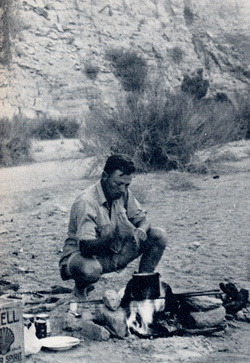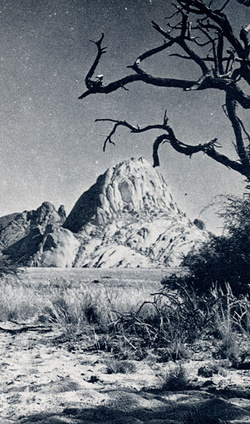This story of climbing the Grosse Spitzkuppe in South West Africa starts in 1938
This travel report by Dr. A. J. Clement had been published in the S.W.A.-Jaarboek of 1975 and describes a mountaineering episode on the Grosse Spitzkuppe, the so-called Matterhorn of South West Africa, in the 1930s and 1940s.
It would be extraordinary if Cape Town, lying at the foot of Table Mountain (3550 feet), had failed to produce a school of rock-climbers of more than average ability. In how many cities in the world can the mountaineer arrive at the foot of a fine mountain within half-an-hour or less of leaving his home? The Mountain Club of South Africa has its headquarters in Cape Town, and there are more than two hundred classified climbs - from A (easy) to G (exceptionally severe) - on local mountain slopes. By the time he has completed this testing course, the Cape Town climber has few peers. One of the finest chapters in South African mountaineering is the teamwork which led to the final conquest of the Great Spitzkop - Southern Africa's 5 200 foot high Matterhorn, and the most striking landmark in South West Africa. The mountain did not succumb easily. Its final conquerors classified some of its pitches as "mechanical- super E", which is probably a fair indication of the problems it posed. The story starts in January, 1938, when Denis Woods - a Cape Town mountaineer - and his friend, L. McDermott set out to spend three months exploring the little-known mountains of South West. They travelled in a dilapidated old Willys called Cleopatra, or Cleo for short. As they followed the twisting road between Okahandja and Otjiwarongo, they caught an occasional glimpse of the cone-shaped, twin peaks of Omatako through the dense bush. Although they were travelling further north, Woods was determined not to leave South West until he had climbed Omatako Spitze - the highest and most striking of the two mountains. To mountaineers like these the Spitze proved easy. The only difficulty was the dense thorn jungle which covered the slopes almost to the top. "Every twig bristled with bards, and even the undergrowth reached up and tore at one's ankles. It was like some strange inferno H. G. Wells might conceive." At the beacon Woods found a tin containing records of previous German ascents, dating back to 1916. From the summit he gazed over miles and miles of wooded plains. Except for the twin peak of Omatako there were no other mountains in the vicinity. Far away, however, he could pick up several peaks - the table-shaped Etjo, the mountains encircling Windhoek, the Waterberg and Erongo Ranges and, in solitary grandeur to the north-west, the barely-discernible outline of the Brandberg (8 550 feet) - the highest mountain massif in S.W.A. Beyond that lay the mysterious Kaokoveld. What impressed him most, however, was his first glimpse to the south west of the sharp, pink granite needle of the legendary Grosse Spitzkoppe (Great Spitzkop). It was quite close to the little town of Usakos and from afar its smooth sides looked impossibly steep. Woods knew that it rose a sheer 3 000 feet from the plain, but that was the challenge.


